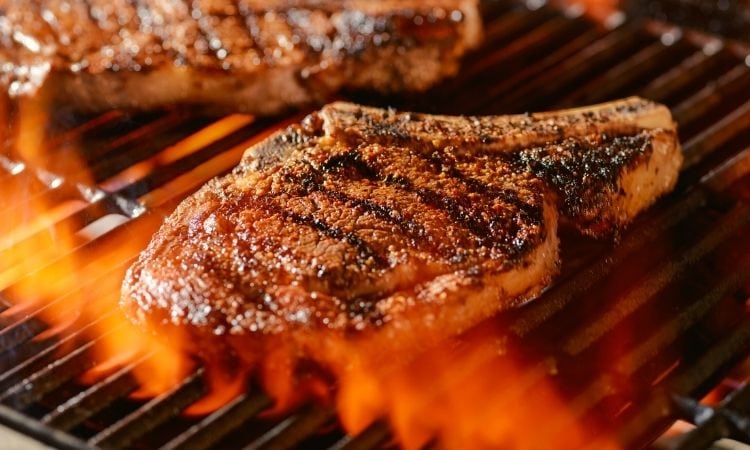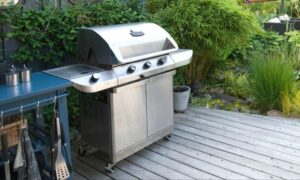Becoming a master of the grill requires becoming a master of temperatures. Some people believe that grilling is an art, but the truth is that anyone can grill if they apply a little science.
To successfully grill any food, you’ll want to be able to control your grill’s output to maintain medium-low through high temperatures.
The most common temperature used for grilling is medium-high — in other words, one that is between 375 to 425 degrees Fahrenheit.
But what about all of these other temperatures? When should you opt for medium or medium-low over medium-high?
Here is an infographic that will give you a quick overview of different grilling temperatures:

Next, let’s take a closer look at the details.
Different Grilling Temperatures Explained
In many ways, cooking on the grill is not very different from baking in the oven. The temperature ranges are similar, too — nearly all recipes you find for baking will be 350, 375, and sometimes as high as 400.
You can cook at lower temperatures, but only for particular purposes. For example, you might get your grill very low — in the 200s — for a smoking recipe. Or, you might blast it as hot as possible for a fast sear.
Medium-Low Heat
Temperatures between 300 and 325 degrees can be considered medium-low. Once you get below 275, you’re in the range of smoking.
That detail hints at one of the benefits of cooking in this temperature range — your food will spend more time on the grill and pick up more smoky flavors. If you want to use a smoker box, a lower temperature and longer cooking time make the results better.
However, many grills are not very good at holding low temperatures without considerable work to get the burner settings just right. Don’t assume that turning the knobs to low will work — you’ll probably have to play with which burners to use to get the grill to maintain medium-low or lower.
If you like cooking at both high and low temperatures, consider getting a pellet grill.

What can you cook on medium-low?
There are no hard limits on what can and cannot be cooked at lower temperatures. Medium-low works for many types of foods. Just remember that everything will take longer to cook with lower temperatures and some meats will end up dry when cooked for too long.
Larger cuts of meat, in particular, may take hours. However, it’s well worth the wait since you’ll get more delicious grill flavor and more tender results. But, you will not see that classic grilling char on your food.
Cooking lower allows the interior to heat more evenly, which means large cuts are less likely to burn on the outside before their centers get entirely cooked. Medium-low is also great for things that might burst, like fresh sausages or hot dogs.
Particularly, medium-low is good for the following foods:
- Hot dogs and sausages
- Ribs
- Pork shoulders
- Poultry, particularly whole birds
Medium Heat
Cooking at medium means aiming for a grill temperature of around 350 degrees.
This range is in the zone of normal oven baking, so it’s perfect for nearly everything you might want to cook.

What can you cook on medium?
Medium temperature is suitable for chicken wings and legs, most fish, and thick cuts of meat that might burn if you let the grill get too hot.
Specifically, medium heat is good for grilling the following foods:
- Poultry (wings and legs)
- Fish
- Bacon
- Thick-cut steaks
- Baking recipes on the grill, like breads or desserts
- Delicate vegetables
Medium-High Heat
Medium-high heat is probably the most commonly used temperature range for grilling recipes. It’s also the one that most grills can comfortably hold if you’re careful.
Medium-high is defined as 375 degrees or higher, to about 425 degrees.
Some pitmasters get their fires too hot to begin with, falsely believing that grilling always requires high heat. Medium-high is a great starting point, but remember, it’s hot enough that some foods will have trouble cooking through without charring and burning on the outside first.

What can you cook on medium-high?
Getting the grill this hot means that you can get your foods medium-rare. The outside will cook fast, while the centers will take longer to heat through.
For this reason, you’ll want to avoid cooking at medium-high or hotter with things that you need to cook through. But if you want your steak to be pink in the center, then medium-high is your starting point.
Medium-high is great for the following foods:
- Steaks
- Burgers
- Kabobs
- Hearty vegetables
High Heat
High heat is 450 degrees or more. It’s tough to get food cooked at this temperature without taking great care.
If you put a piece of chicken on this temperature grill, it will likely char or even be engulfed in flames before long. That might sound like more flavor to you, but unfortunately, the center will still be raw.
So you must reserve high heat for things you can cook very quickly or for foods that you want to sear and then move off of the high heat. By combining direct high heat and indirect medium heat, you can get that perfect sear and finish cooking the meat to your desired temperature.

What can you cook on high?
If you go by the grill sales brochures, producing high heat is the essential function of the grill. But this isn’t actually the case, and the uses for a grill that gets this hot are more limited than you might believe.
Particularly, high is good for the following foods:
- Rare-cooked steaks
- Thin-cut steaks or meats for fast cooking (i.e., fajitas)
- Kabobs (beef & lamb)
- Seared tuna steaks
- Seared steaks (follow with a lower temperature to cook to doneness)
If your gas grill is not getting hot enough, make sure to check that your regulator is working properly and there are no leaks.
Why a Good Grill Temperature Gauge is Essential
All of this information is useless if you can’t tell what temperature your grill is holding.
Be wary of anyone who tells you they can “feel” for the hot spots and know from experience how hot their grill is. Yes, this is possible but requires a lot of experience.
There is only one sure way to know when a grill has reached the appropriate cooking temperature. You must use a thermometer.

Most of us use simple analog thermometers that come built-in to our grills. The hood-mounted thermometers are usually pretty accurate, although some have their quirks. But since these are mounted right above your food, they have a prime location from which to monitor the proceedings.
Another option, should you want to get more accurate, is a grill surface thermometer. These analog scales look like a burger patty — they sit right on the grates next to your food. It’s the most accurate thing to measure the temperature on the grates, and it’s also helpful in mapping out the hot spots on your grill.
Finally, two other thermometers can also be very helpful:
Instant-Read Thermometer: Get a handheld infrared model that can take the temperature off the grates. That’s super helpful for a quick and accurate temperature reading without even having to stick your hands in there.
Remote-Probe Thermometer: Allows you to measure the temperature of your food as it cooks. That’s a beautiful thing to have with big cuts of meat on the grill. Set your thermometer carefully, and it will alert you when your food is ready to come off the heat.
Grilling on Medium-High Temperature – Final Thoughts
You can’t do any cooking without playing with a bit of science. And thermometers are a big part of that.
Know what grilling temperature you need, make sure your grill holds that temperature, and check that your food is cooked to the right temperature.
And even if you fail a few times — keep on grilling!








